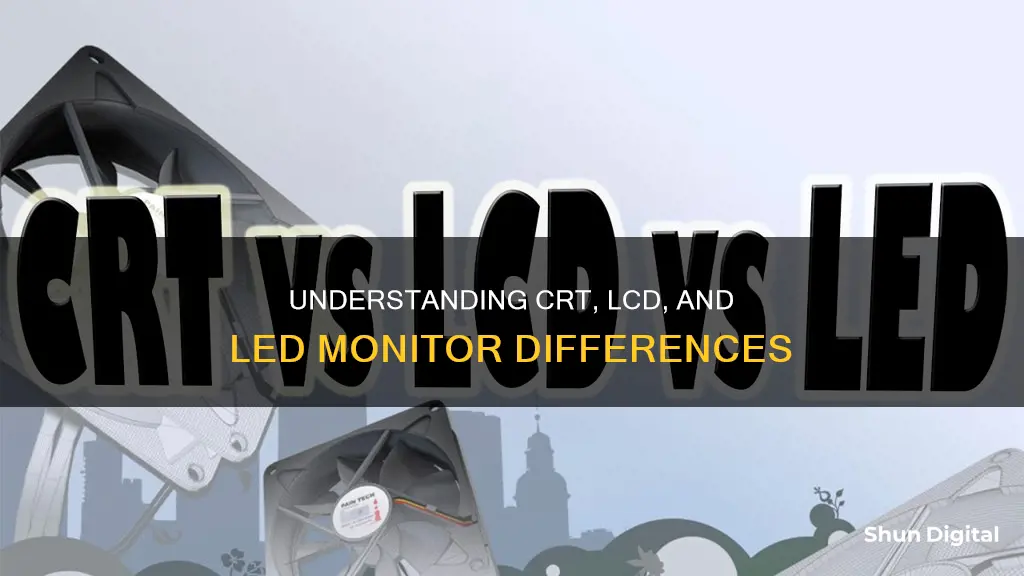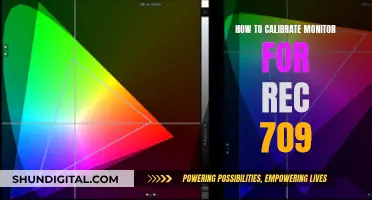
CRT, LCD, and LED monitors are the most commonly used display technologies for televisions and computer screens. CRT stands for Cathode Ray Tube, LCD for Liquid Crystal Display, and LED for Light-Emitting Diode. Each of these display technologies differs in terms of functionality, performance, size, weight, cost, and environmental impact.
Characteristics of CRT, LCD, and LED Monitors
| Characteristics | Values |
|---|---|
| Type | CRT: Cathode Ray Tube. LCD: Liquid Crystal Display. LED: Light-Emitting Diode |
| Image Quality | CRT: Better colour rendering, greater colour clarity and depth. LCD: Reduced colour clarity. LED: Superior display, no flickers |
| Size | CRT: Larger and heavier. LCD: Smaller, lighter, and compact. LED: Slim and lightweight |
| Resolution | CRT: Lower resolution. LCD: Higher resolution, fixed resolution. |
| Power Consumption | CRT: Higher power consumption. LCD: Energy-efficient. LED: Low power consumption |
| Radiation | CRT: Emit electromagnetic fields and X-ray band radiation. LCD: Low radiation emission. LED: Can cause health issues like photosensitive epilepsy and retinal damage |
| Weight | CRT: 40 pounds or more. LCD: 8-10 pounds. LED: Slim and lightweight |
| Cost | CRT: Cheapest. LCD: Affordable. LED: Most expensive |
| Response Rate | CRT: Fast response rate. LCD: Slow response rate. LED: Best response rate |
| Lifespan | CRT: Durable. LCD: Delicate, requires careful use. LED: Average lifespan of 50,000 hours or 15 years |
What You'll Learn

CRT monitors are larger and heavier than LCD monitors
The large size and weight of CRT monitors are due to the technology used in their construction. CRT monitors use a vacuum glass tube with an electron gun at one end and a phosphorescent screen at the other. The electron gun emits electron beams that are channelled towards the screen, causing it to emit light and display visuals. This technology requires a lot of space and heavy components, making CRT monitors bulky and heavy.
LCD monitors, on the other hand, use a different technology that allows them to be much thinner and lighter. LCD screens are made up of numerous pixels that are situated in front of a reflector or light source. These pixels are controlled by an electrical charge applied between two glass plates, creating visuals without the need for bulky vacuum tubes or electron guns.
The size and weight difference between CRT and LCD monitors have significant implications for their use. The smaller and lighter LCD monitors are easier to handle and can fit into smaller, tighter spaces. They are also more convenient for wall mounting, as the large size and weight of CRT monitors make them unsuitable for wall mounting.
In addition to the size and weight difference, CRT and LCD monitors also differ in other aspects such as power consumption, image quality, and cost. CRT monitors consume more power, generate excess heat, and are more prone to display issues such as glare and image burn-in. LCD monitors, being a newer technology, offer improved image quality, higher resolutions, and reduced eye fatigue. They are also more environmentally friendly and have a bigger viewable area.
Unlock AMD FreeSync on Your ASUS Monitor
You may want to see also

LCD monitors have a higher resolution than CRT monitors
LCD monitors offer a higher resolution than CRT monitors. The LCD screen is made up of numerous pixels that are either colour or monochrome, and these pixels are placed in front of a light source or reflector. The LCD grid can mask the effects of spatial and grayscale quantization, creating the illusion of higher image quality. The higher resolution of LCD monitors is one of the reasons they have become the current standard for desktop computer systems.
The higher resolution of LCD monitors also contributes to their compact size and lightweight design. The pixels are placed between two glass plates, with the back glass lined with a conductive film and the front glass coated with the intended characters. This setup allows for a thinner and lighter monitor that is easier to transport and install.
In contrast, CRT monitors are much larger and heavier. The physical size of a CRT monitor is much bigger than an LCD monitor, often making them awkward on small desks. A CRT monitor can weigh 40 pounds or more, depending on its size, while an LCD monitor typically weighs between 8 and 10 pounds.
The higher resolution of LCD monitors also has advantages for eye comfort. The lower intensity of LCD monitors, coupled with the constant screen display of pixels being on or off, is easier on the eyes and can reduce eye fatigue. However, some people may experience issues with the fluorescent backlights used in some LCDs.
While CRT monitors offer better colour rendering and depth, their lower resolution can result in blurry images outside their natural resolution. CRT monitors can easily scale to various resolutions, but their fixed resolution can be a disadvantage for LCD monitors. An LCD screen can only display the number of pixels in its matrix, and displaying a lower resolution can lead to a blurry or fuzzy picture.
Overall, the higher resolution of LCD monitors makes them more versatile, portable, and comfortable for extended use compared to CRT monitors.
Monitoring Memory Usage: EMR Spark Management Strategies
You may want to see also

CRT monitors have a faster response time than LCD monitors
CRT stands for Cathode Ray Tube, while LCD stands for Liquid Crystal Display. CRT monitors are larger and heavier than LCD monitors, which are smaller and lighter, making them easier to transport and install. CRT monitors also consume more power and generate excess heat compared to LCD monitors.
The faster response time of CRT monitors is due to their ability to easily scale to various resolutions. By adjusting the electron beam in the tube, CRT monitors can display lower resolutions while maintaining picture clarity. This capability, known as multisync, is not available in LCD monitors, which have a fixed resolution.
While LCD monitors have improved over the years, CRT monitors still offer superior colour clarity and depth. This is because CRT monitors integrate light generation and modulation, while LCD monitors isolate these two processes. The contrast ratios and colour depth displayed on CRT monitors are better than what LCD monitors can render.
Water Usage Monitoring in California: How Does It Work?
You may want to see also

LCD monitors are more energy-efficient than CRT monitors
LCD monitors, on the other hand, are more compact and lightweight, and energy-efficient. They are easier to transport and fit into smaller spaces. In terms of energy consumption, a 19-inch LCD monitor uses around 17 to 31 watts on average, whereas a 17-inch CRT monitor can use up to 80 watts. This difference in power consumption makes LCD monitors a more environmentally friendly option.
The higher energy efficiency of LCD monitors also leads to less heat generation. CRT monitors are known to generate excess heat due to their high power consumption, which can be uncomfortable and contribute to higher air conditioning costs. LCD monitors, with their lower power requirements, produce less heat, making them more comfortable and cost-effective to use.
Additionally, LCD monitors offer a larger viewable area despite their smaller size. For example, a 19-inch LCD monitor provides a diagonal screen size of 19 inches, while a 19-inch CRT monitor's viewable area is only about 18 inches. This means that LCD monitors provide more screen real estate without taking up as much physical space.
The energy efficiency of LCD monitors also contributes to their longer lifespan. CRT monitors are prone to issues such as image burn-in, where a static image left on the screen for too long can cause a permanent ghost image. LCD monitors, on the other hand, are not affected by burn-in or ghosting issues, ensuring a longer-lasting display.
In summary, LCD monitors are more energy-efficient than CRT monitors due to their lower power consumption, reduced heat generation, larger viewable area, and resistance to image burn-in. These advantages make LCD monitors the preferred choice for modern computing, offering a more compact, environmentally friendly, and cost-effective solution.
Understanding Aspect Control and Overscan on ASUS Monitors
You may want to see also

CRT monitors are cheaper than LCD monitors
The reason for the price difference is that CRT monitors are an older technology, and they are no longer being manufactured due to cost and environmental concerns. This means that the only way to acquire a CRT monitor is to buy one second-hand, and these are often available for very low prices.
While CRT monitors are cheaper, they are also larger and heavier than LCD monitors, which can make them awkward to fit on small desks. CRT monitors also use more energy and generate excess heat, which can be a disadvantage in terms of running costs and comfort.
LCD monitors, on the other hand, are smaller, lighter, and more energy-efficient. They are also less prone to display issues like image flickering, and they don't suffer from "burn-in" where an image is left on the screen for too long and becomes permanently visible.
Monitor Size: Performance Impact and Visual Experience
You may want to see also
Frequently asked questions
CRT stands for Cathode Ray Tube, LCD for Liquid Crystal Display, and LED for Light-Emitting Diode. CRT monitors are bulkier and heavier, while LCD and LED monitors are more compact and lightweight. CRT monitors also consume more power and produce more heat.
LCD monitors are smaller, lighter, and more energy-efficient than CRT monitors. They also have a slightly bigger viewable area and don't suffer from image burn-in or ghosting issues.
LCD monitors have a fixed resolution, which can lead to blurry or fuzzy images when displaying lower resolutions. They also have a slower response rate than CRT monitors, which can be a disadvantage for gaming.
CRT monitors emit electromagnetic fields and X-ray band radiation, which can be harmful to human health. LCD monitors don't emit high doses of radiation, but they have been linked to issues such as insomnia and fatigue. LED monitors can cause health issues such as photosensitive epilepsy and retinal damage.
LED monitors are generally the most expensive, followed by LCD and CRT monitors. LED monitors can cost $1000 or more, while LCD monitors typically range from $100 to $200. CRT monitors are the cheapest and can often be found used for very low prices.







